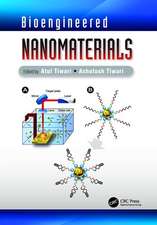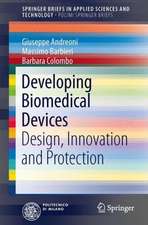Advanced Technologies in Cardiovascular Bioengineering
Editat de Jianyi Zhang, Vahid Serpooshanen Limba Engleză Paperback – 7 feb 2023
| Toate formatele și edițiile | Preț | Express |
|---|---|---|
| Paperback (1) | 1040.14 lei 6-8 săpt. | |
| Springer International Publishing – 7 feb 2023 | 1040.14 lei 6-8 săpt. | |
| Hardback (1) | 1049.38 lei 3-5 săpt. | |
| Springer International Publishing – 6 feb 2022 | 1049.38 lei 3-5 săpt. |
Preț: 1040.14 lei
Preț vechi: 1094.89 lei
-5% Nou
Puncte Express: 1560
Preț estimativ în valută:
199.05€ • 216.14$ • 167.21£
199.05€ • 216.14$ • 167.21£
Carte tipărită la comandă
Livrare economică 23 aprilie-07 mai
Preluare comenzi: 021 569.72.76
Specificații
ISBN-13: 9783030861421
ISBN-10: 3030861422
Pagini: 407
Ilustrații: X, 407 p. 74 illus.
Dimensiuni: 155 x 235 mm
Greutate: 0.64 kg
Ediția:1st ed. 2022
Editura: Springer International Publishing
Colecția Springer
Locul publicării:Cham, Switzerland
ISBN-10: 3030861422
Pagini: 407
Ilustrații: X, 407 p. 74 illus.
Dimensiuni: 155 x 235 mm
Greutate: 0.64 kg
Ediția:1st ed. 2022
Editura: Springer International Publishing
Colecția Springer
Locul publicării:Cham, Switzerland
Cuprins
Part I: Cardiac development and morphogenesis
1) From simple cylinder to four-chambered organ: a brief overview of cardiac morphogenesis
2) Lineage Tracing Models to Study Cardiomyocyte Generation during Cardiac Development and Injury
3) Mechanisms that govern endothelial lineage development and vasculogenesis
Part II: Cellular approaches to cardiac repair and regeneration
4) Remuscularization of Ventricular Infarcts Using the Existing Cardiac Cells
5) Allogeneic immunity following transplantation of pluripotent stem cell-derived cardiomyocytes
6) Vascular regeneration with induced pluripotent stem cell-derived endothelial cells and reprogrammed endothelial cells
7) The guinea pig model in cardiac regeneration research; Current tissue engineering approaches and future directions
Part III: Genetic approaches to study cardiac differentiation and repair
8) Analyzing genetic programs of cell differentiation to study cardiac cell diversification
9) Recombinant Adeno-Associated Virus for Cardiac Gene Therapy
Part IV: Bioengineering approaches to cardiovascular tissue modeling and repair
10) Microfabricated Systems for Cardiovascular Tissue Modeling
11) Bioengineering of Pediatric Cardiovascular Constructs: In Vitro Modeling of Congenital Heart Disease
12) Biomaterial Interface in Cardiac Cell and Tissue Engineering
13) Stem Cell-based 3D Bioprinting for Cardiovascular Tissue Regeneration14) Creating and Validating New Tools to Evaluate the Electrical Integration and Function of hPSC-derived Cardiac Grafts in Vivo
Part V: Clinical perspectives
15) Understanding the Molecular Interface of Heart Disease and COVID-19: A Data Science Approach
16) Clinical Application of iPSC Derived Cardiomyocytes in Patients with Advanced Heart Failure17) Cell Therapy with Human ESC-derived Cardiac Cells: Clinical Perspectives
Notă biografică
Jianyi “Jay” Zhang, M.D., Ph.D., F.A.H.A., is an international leader in myocardial bioenergetics, biomaterials, and pluripotent stem cells (PSC) for cardiac repair. He is tenured Professor of Medicine and of Engineering; T. Michael and Gillian Goodrich Endowed Chair of Engineering Leadership; and the Chair of the Department of Biomedical Engineering (BME), a joint department of the School of Medicine and School of Engineering, at the University of Alabama at Birmingham (UAB). He came to UAB in 2015 after he was chosen in a national search to lead the UAB BME department from the University of Minnesota Medical School, where he was the Engdahl Family Foundation Chair in Cardiovascular Regenerative Therapies, in addition to being a tenured professor of medicine, of biomedical engineering, of electrical engineering, and computer engineering. Dr. Zhang earned his M.D. from Shanghai Medical University and his Ph.D. in biomedical engineering from the University of Minnesota. He also earned a Master of Science in engineering and a certificate of business administration from Tuft University. Prior to joining the faculty at the University of Minnesota, Dr. Zhang completed postdoctoral work in that university’s cardiovascular division. His research interests include tissue engineering, myocardial energetics in hearts with postinfarction left-ventricle remodeling, heart failure, biomaterials, and human induced pluripotent stem cells for cardiac repair. He is currently the principal investigator of four R01 NIH grants in the fields of myocardial bioenergetics, biomaterials, and stem cells for cardiac repair, NIH BIB T32 training grant, and an NIH U01 grant for the NHLBI Progenitor Cell Translational Consortium (PCTC) on cardiovascular tissue engineering, which continuous through 2025.
Textul de pe ultima copertă
This book presents a systematic overview of the technologies currently being explored and utilized in the fields of cardiovascular tissue engineering and regenerative medicine. Considering the unprecedented rapid progress occurring on multiple technological fronts in cardiac tissue engineering, this important new volume fills a need for an up-to-date, comprehensive text on emerging advanced biological and engineering tools. The book is an important resource for anyone looking to understand the emerging topics that have the potential to substantially influence the future of the field. Coverage includes iPS stem cell technologies, nanotechnologies and nanomedicine, advanced biomanufacturing, 3D culture systems, 3D organoid systems, genetic approaches to cardiovascular tissue engineering, and organ-on-a-chip. This book will be a valuable guide for research scientists, students, and clinical researchers in the fields of cardiovascular biology, medicine, and bioengineering, as well as industry-based practitioners working in biomaterial science, nanomaterials and technology, and rapid prototyping and biomanufacturing (3D bioprinting).
- Examines rapidly emerging technologies in the field of cardiovascular tissue engineering;
- Covers state-of-the-art biomanufacturing techniques;
- Presents basic science and engineering concepts, coupled with clinical and translational advancements.
Caracteristici
Examines rapidly emerging technologies in the field of cardiovascular tissue engineering
Covers state-of-the-art biomanufacturing techniques
Presents basic science and engineering concepts, coupled with clinical and translational advancements
Covers state-of-the-art biomanufacturing techniques
Presents basic science and engineering concepts, coupled with clinical and translational advancements



























